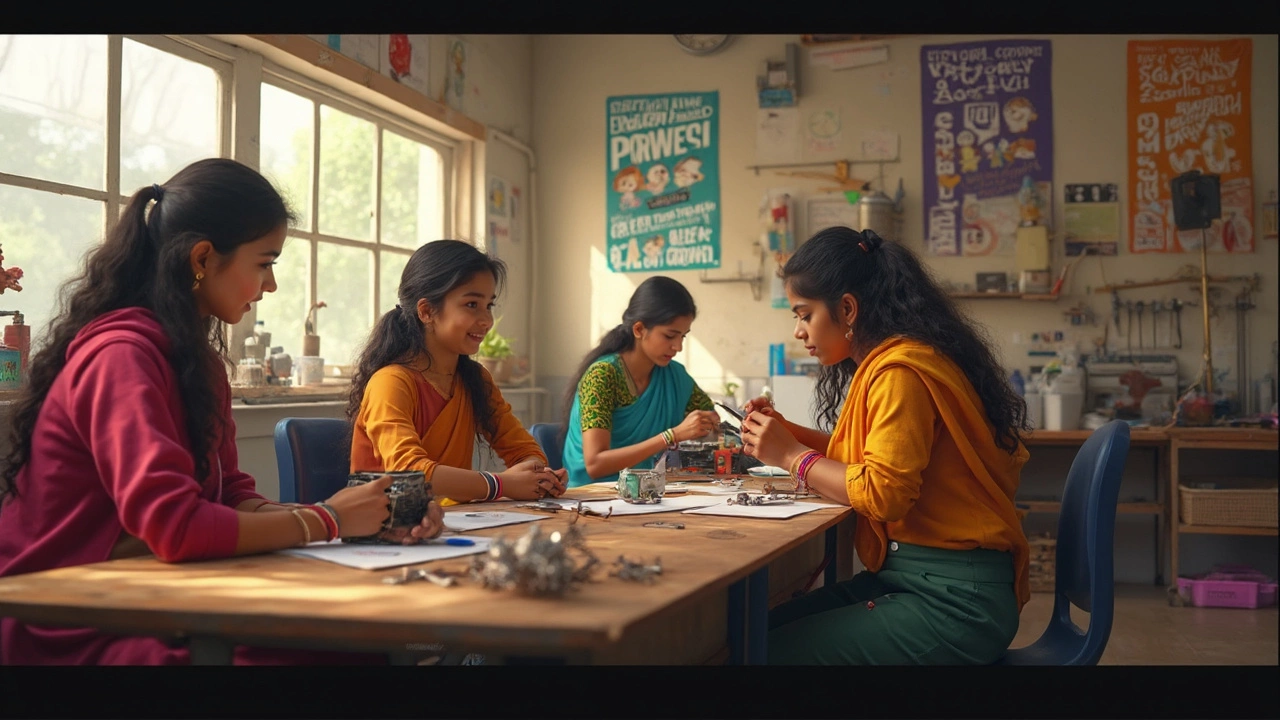
You’ve probably heard the word “vocation” thrown around, but what does it really mean? It’s not just a fancy term for a job. A vocation is a specific skill-based career, usually something you can train for in less time than a traditional college degree. Think of roles like electrician, bakery chef, dental assistant, or beauty professional—jobs where you learn by doing, not just studying theory.
For women looking to skip endless classroom hours or student debt, vocational training opens up tons of possibilities. A lot of programs can be finished in months, not years. That means you can start earning faster, and you get actual hands-on experience—no need to sit through boring lectures you’ll never use at work.
- What Is a Vocation Anyway?
- Hands-On Examples: Popular Vocational Fields for Women
- What Makes Vocational Training Different?
- Stories from Real Women Who Chose the Vocational Route
- Tips to Get Started with Vocational Training
- Turning Skills into Steady Income
What Is a Vocation Anyway?
A vocation is not just any job—it’s about learning a skill that gets you right into work. While lots of people chase university degrees, a vocation example usually means hands-on training that leads straight to paid work after course completion. For instance, if you train to become a medical lab technician, you’re getting skills that employers need right now—not in four years, but as soon as your program ends.
Vocations are about practical skills, not textbook theory. You learn by doing, whether you’re fixing computers, running a salon, or working in childcare. That’s why vocational training appeals to many women who want to quickly switch careers or start earning faster than typical university paths allow.
Here’s what sets a vocation apart:
- Shorter training time compared to degrees (sometimes just 6-12 months)
- Focus on job-ready skills—less theory, more practical
- Training usually includes real-world practice, like internships or workshops
- Courses prepare you for specific careers in healthcare, crafts, beauty, food, and more
In India, about 90% of jobs require some sort of vocational or technical skill, not a university degree. In fact, a Ministry of Skill Development report showed in 2023 that women made up 40% of enrollments in government vocational programs. This means more women are realizing you don’t need a formal degree for a stable, decent-paying career.
| Vocation | Typical Training Time | Industries |
|---|---|---|
| Beautician | 6-12 months | Beauty & Wellness |
| Nursing Assistant | 1 year | Healthcare |
| Tailor | 6 months | Apparel |
| Bakery Chef | 9 months | Food Services |
Pick a vocation, and you’re not just getting a job—you’re choosing a practical road with clear steps and a real demand in the market. That’s why more women are looking at vocational training as their pathway to financial independence and career satisfaction.
Hands-On Examples: Popular Vocational Fields for Women
If you’re wondering which vocational paths are really working for women, you’ve got options. These fields don’t just pay the bills—they open up real careers without forcing you to slog through four years of college. Let’s run through some tried-and-tested examples:
- Healthcare Support (the most important keyword: vocation example) – Nursing assistants, lab technicians, and medical office support roles are in serious demand. Women make up around 85% of the nursing assistant workforce in India, according to 2023 government stats. Training often takes less than a year, and you’re ready for a stable job.
- Beauty and Wellness – Think makeup artists, beauty therapists, hair stylists, and skin care specialists. Beauty services in India are worth over $13 billion, and women are the backbone of this industry. Many vocational training centers now include digital marketing lessons, so you can even run your own business.
- Tailoring and Fashion Design – From stitching uniforms to designing wedding outfits, tailoring courses pack in practical skills that don’t need fancy machines or shops to get started. Lots of women now sell on Instagram or WhatsApp, making side money from home.
- Bakery and Food Services – Professional bakeries, cloud kitchens, and food trucks are booming, with plenty of women finding success after short-term food production courses. It’s hands-on, creative, and perfect for women with cooking skills.
- Early Childhood Education – Becoming a pre-school teacher or childcare worker is another solid pick. The early education sector in India is expected to touch $5 billion by 2025, and well-trained professionals are valued.
If you’re still on the fence, here’s a quick look at average course durations and starting salaries:
| Field | Course Duration | Estimated Starting Salary per Month (INR) |
|---|---|---|
| Healthcare Support | 6-12 months | ₹10,000 - ₹18,000 |
| Beauty and Wellness | 3-6 months | ₹8,000 - ₹20,000 |
| Tailoring/Fashion Design | 3-9 months | ₹7,000 - ₹15,000 |
| Bakery & Food Services | 2-6 months | ₹8,000 - ₹16,000 |
| Early Childhood Education | 6-12 months | ₹8,000 - ₹18,000 |
All these paths let you build skills while you learn, and jobs are available in both big cities and small towns. If you’re aiming for steady work, fast learning, and a clear next step, these vocational options deliver.
What Makes Vocational Training Different?
The big thing about vocational training is how direct and practical it is. You skip a lot of theory and boring general subjects that you’d get in regular college. Classes get straight to the point, teaching you the exact skills you’ll need for the job—no extra filler.
Take something like a beauty therapy course. You’ll actually practice hair styling and skincare routines, not just read about them. If you’re learning to be an electrician, you’re wiring real switches and outlets, not just looking at diagrams in a textbook. Most vocational programs are loaded with hands-on workshops, and many include internships or apprenticeships. That means you learn by doing right from the start.
Another big difference is the time it takes. Most vocational courses can be finished in one or two years, sometimes even quicker. You could become a certified medical lab assistant in six to nine months, or pick up bakery skills in less than a year.
Vocational training often links you directly to jobs, too. Many programs have partnerships with local companies or government agencies, so by the time you finish the course, you might already have an interview lined up. This is especially true for in-demand fields like healthcare, IT support, and the vocational training opportunities in skilled trades.
Plus, there’s less stress about big tuition fees or student loans. Since courses are shorter and more focused, the costs are way lower than a traditional four-year college degree. That frees you up to start earning (and saving) much sooner.

Stories from Real Women Who Chose the Vocational Route
The whole "follow your passion" thing sounds good, but sometimes you need real proof that a path works. Let’s talk about some actual women who went down this road and how it played out for them.
Meera Patel from Surat didn’t want to spend four years in college, but she needed a solid income. She signed up for a certified tailoring program. In less than a year, she launched her own home-based tailoring business. Now, she pulls in about ₹30,000 a month. She’s not just earning for herself—she hired two other women from her neighborhood too.
Pooja Sharma from Delhi went for a vocation example a lot of people don’t consider: dental hygiene. After a one-year course, she landed a job at a big clinic with a salary of ₹22,000. The best part? She doesn’t work weekends, so balancing home life is actually possible for her.
Then there’s Nazia Yunus from Bengaluru. She loved fixing things around the house, so she went for electrical training. It's not the first field that comes to mind for women, but Nazia landed a maintenance job in a tech park. Salaries for women in technical trades have been rising—trade industry data from 2024 shows a 15% yearly increase in earnings for certified female electricians in Indian cities.
Check out this quick breakdown of what some women are earning in different vocational careers:
| Vocational Path | Location | Annual Average Income (INR) |
|---|---|---|
| Tailoring & Boutique Owner | Surat | 3,60,000 |
| Dental Hygienist | Delhi | 2,64,000 |
| Electrician | Bengaluru | 3,00,000+ |
| Beauty Stylist | Pune | 2,40,000 |
If you talk to these women, a theme pops up—they wanted more control of their time and decent pay without years stuck in classrooms. Whether it’s beauty, tech, or health care, vocational training is letting women write their own success stories on their own terms.
Tips to Get Started with Vocational Training
Jumping into vocational training feels less overwhelming when you know what to expect. Most women start with a clear goal, like aiming for a job that’s growing or one that fits daily life better than a traditional 9-to-5. Start by figuring out where you want to land. For example, jobs like health care assistant, early childhood educator, or digital marketing specialist are in high demand right now.
Here’s a simple way to kick off your journey:
- Research your options: Don’t just look up “vocational courses.” Find out which ones match your interests and skills. Visit government sites or verified job portals for real data about job growth and pay scales.
- Check the program’s credibility: Always go for certified institutions. In a 2023 report from the Ministry of Skill Development and Entrepreneurship, women placed from certified institutes had job placement rates that were almost 20% higher than those from uncertified courses.
- Get hands-on: Go for training programs that offer real-world projects or internships. 78% of women who did internships during their training reported getting hired within 3 months after finishing the program.
- Find support: Look for scholarships, financial aid, or community programs. The National Skill Development Corporation (NSDC) offers financial help for women in several vocational courses.
- Network: Join local or online groups in your chosen field. Many jobs come from word of mouth or personal connections rather than online applications.
If you’re worried about costs, check out the table below for the average course fees and starting salaries for some popular fields:
| Field | Average Training Cost (INR) | Typical Starting Salary (INR/year) |
|---|---|---|
| Healthcare Assistant | 15,000 - 40,000 | 120,000 - 200,000 |
| Beautician | 10,000 - 25,000 | 100,000 - 180,000 |
| Digital Marketing | 20,000 - 50,000 | 150,000 - 250,000 |
| Tailoring/Fashion Design | 8,000 - 35,000 | 90,000 - 160,000 |
Before shelling out cash, visit some training centers, ask graduates about their experience, and explore short certificate workshops first. Small steps now can save a ton of time and money in the long run.
Turning Skills into Steady Income
Once you've got a trade under your belt, you’re holding something more powerful than a shiny certificate—you’ve got earning power. The cool thing with a vocation example like tailoring, childcare, or baking is that there’s always a need for these skills in the real world. Women across India and beyond have built real businesses and stable jobs with the skills they picked up in vocational training.
Let’s talk numbers. According to the National Skill Development Corporation in India, women with vocational training are 46% more likely to secure employment versus those who rely only on general education. That’s a pretty convincing reason to give it a shot.
But how do you go from skill to cash in the bank? Here are some practical ways women have turned classroom know-how into a paycheck:
- Freelancing or running your own shop: Hairdressers, tailors, and beauticians often start at home, then open small salons or boutiques.
- Getting hired by companies: Certified nurses, paralegals, or electricians often find jobs fast since companies are hunting for hands-on talent.
- Partnering with marketplaces: Platforms like UrbanClap or online food delivery apps have made it easier for people to find clients after finishing their training.
Consistency and keeping your skill updated is key for steady growth. Short upskilling courses every now and then can help raise your rates or even open up new work options.
"When women have economic power through skills, their choices open up—at home and in society." — National Skill Development Corporation (2023 report)
Here’s a quick look at what average monthly incomes can look like across some popular vocational fields for women:
| Vocational Field | Average Monthly Income (INR) |
|---|---|
| Beauty & Wellness | 18,000–35,000 |
| Tailoring/Dressmaking | 10,000–25,000 |
| Bakery/Cooking | 12,000–30,000 |
| Healthcare Support | 20,000–40,000 |
| Data Entry/IT Support | 15,000–28,000 |
What’s striking is you don’t need fancy degrees to earn a living wage—or even more than that. Plenty of women double their household income within a year or two of completing proper training. The key is to pick a skill that suits your personality and local demand, keep hustling, and tap into support networks and new online platforms.
